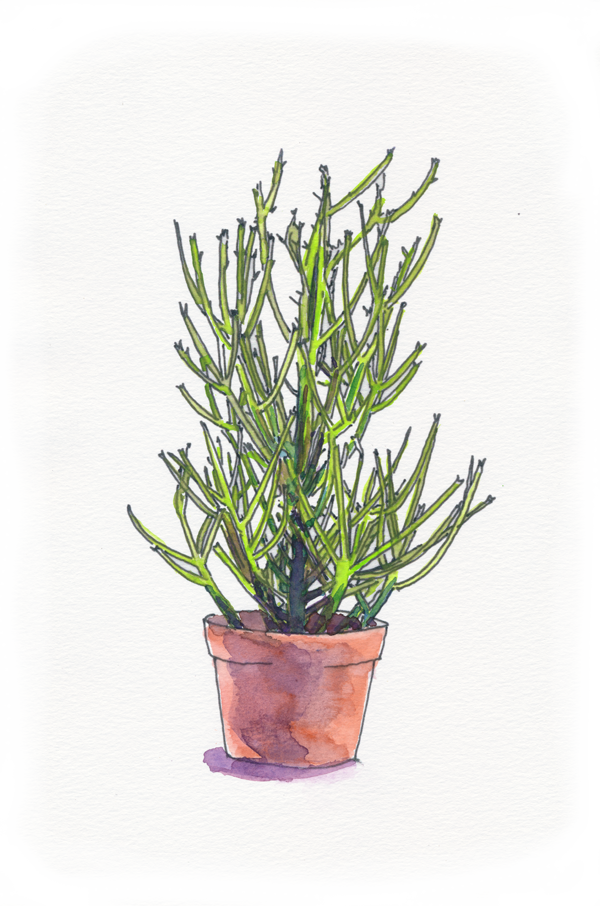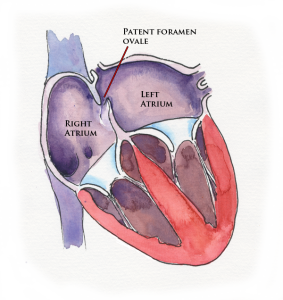By Brandon Munsell NREMT-P , WEMT-P, SOLO Instructor
A Cactus! Oh how our legs and hands quiver at the mention of these spiny land urchins…but it may well be the spike-less Pencil Cacti that should send danger signals to those who venture into the southern climates.
In this article we are going to explore the Pencil Cactus or Euphorbia tirucali from a EMS perspective.
The Pencil Cactus, or Milkbush, is not a true cactus at all but rather belongs to the Euphorbia family. It originates from the tropical and subtropical regions of Africa and India. This family also includes the festive poinsettia and the Cathedral Cactus.
Out in the bush it can grow as tall as 30-feet and is a leafless plant that has tendril like green branches that are about the width of a pencil. When no growth begins at the distal end, tiny leaves may briefly appear before falling.
This attractive plant has become a popular large houseplant that can reach ceiling height when given a couple years in a properly-sized container. As the size increases, large limbs fall off. This species has also gained popularity as a landscaping plant in the Southern U.S.
https://www.wildernessmedicinenewsletter.com/wp-content/uploads/2014/10/wmnlogo20151.png00WMN Editorshttps://www.wildernessmedicinenewsletter.com/wp-content/uploads/2014/10/wmnlogo20151.pngWMN Editors2015-08-07 15:07:542015-08-07 15:12:08Pencil Cactus or Euphorbia tirucali
By Jeff Toorish NREMT-P, WEMT, GeoMEDIC, I/C –A SOLO Instructor
The foramen ovale is a small orifice located in the atrial septum. Its purpose is to enhance the circulation of blood during fetal development. A fetus in the womb does not use its own lungs to oxygenate blood because its lungs are not yet developed having had no exposure to air. Instead the fetus relies on oxygen from the mother via the umbilical cord. For this reason, blood must travel directly from the right atrium of the fetal heart to the left atrium of the fetal heart through the foramen ovale, bypassing a trip to the right ventricle and, ultimately, the undeveloped fetal lungs.
Increased blood pressure at birth normally closes the foramen ovale and it normally becomes permanently sealed during the first months of life in most people. If this hole in the atrial septum does not close properly it retains patency and is called a patent foramen ovale (PFO), which normally presents as a flap-valve that only opens during certain conditions. If the pressure is great enough, oxygen poor blood will travel directly from the right atrium of the heart to the left atrium. This is also a gateway for clots to travel more easily through the heart.
Approximately 25 percent of people in the general population have PFO, although many will never know it. That number increases in specific population cohorts and PFO is linked to stroke, seizure, migraine headaches, increased decompression sickness in divers, and increased diagnoses of HAPE in climbers. Remarkably, many front line and pre-hospital providers have never heard of PFO and even in hospital settings it is often overlooked. In this report I will explore these hidden dangers and its potential impact in the pre-hospital setting.
A spectacular day of snorkeling in the Caribbean Sea off the island of St. John, USVI is temporarily interrupted by an itchy, red rash on the sides and abdomen of one of the swimmers. What the heck is that all about?
She states that she did not feel any pain, stings, or itchiness while in the water. The rash came on about an hour after getting out of the ocean and seemed to coincide with jumping into the freshwater pool back at their villa to rinse off. She states that as she got out of the pool, she felt stinging sensations on her sides and abdomen. While snorkeling, she had been wearing a t-shirt over her bathing suit to protect her back from sunburn.
After a bit of research, it turns out that the rash is referred to as a seabather’s eruption or pica pica, and is caused by “sea lice.” The misnomer is that the rash is not caused by “sea lice,” which are fish ectoparasites, but instead, by the teeny, tiny larvae of the thimble jellyfish.
The Thimble Jellyfish, Linuche unguiculata, also known as a sea thimble or button jellyfish is a small, (strangely enough) thimble-sized, 13 – 20mm jellyfish. Even though it does have nematocysts, stinging cells, it is not considered a threat to humans.
Approximately 56,000,000 people die per year (a little less than 1%)
Communicable Infectious Disease – deaths per year:
Infectious Disease – 13.1 million deaths per year out of the 56 million
Malaria – 219 million new cases per year, with 1.2 million deaths
Tuberculosis – 9 million new cases per year, with 1.1 million deaths
HIV/AIDS – 35 million people living with AIDS, with 1.5 million deaths
Respiratory Tract Infections, viral influenza – 3.1 million deaths per year
Diarrheal Disease – 1.7 billion cases per year, with 1.5 million deaths in children
less than 5 years of age, #2 cause of death in children. #1 is pneumonia
Non-communicable, Non-infectious Disease – deaths per year:
(Infectious disease 13.1 million deaths per year)
Ischemic Heart Disease 7 million
Stroke 6.7 million
COPD 3 million
Lungs Cancers 1.6 million
Diabetes mellitus 1.5 million
Road Injury/Trauma – MVA 1.3 million
Hypertensive Heart Disease 1.1 million
It is estimated that communicable or infectious disease accounts for 48% of deaths worldwide each year. For travelers and the adventurous, who dare to leave the familiarity and safety of their own homes, part of being safe and staying healthy is understanding how large the world of infectious disease is and how it can and will impact your health and happiness.
Over the years we authored a lot of articles on various types of infectious diseases. In this article we are going to focus on and review the various infectious diseases that one can acquire from rodent, bat, and bird droppings, i.e., urine, guano, poop.
You have to wonder: who cares about the risk of infectious diseases that can be spread by the droppings of rodents, bats, or birds? Although these various illnesses are not all that common, they are common enough to be concerned about, easy to prevent, and can be hard if not impossible to treat, which can lead to long-term illness or even death.
Poop: droppings, excrement, feces, guano, stool, and of course everyone’s favorite sh*t.
Various animals can act as reservoirs in nature and harbor infectious diseases that may be harmless to them, but can cause illness in humans. Some of these diseases can be spread from the animal to humans by insect vectors such as mosquitoes, ticks, black flies, or fleas, to name a few. However, some of these diseases can also be transmitted in an animal’s saliva, urine, and/or feces. It is these animal secretions and excretions that are the vector for spreading disease. If the poop, urine, or saliva harbors the disease, and these excrements manage to become airborne or aerosolized and inhaled by a human, that unfortunate person can become infected with that illness.
This aerosolized contact is a common risk for cave explorers who may find themselves walking in or crawling in dried bird, bat, and or rodent droppings. An example is the hantavirus outbreak in the US Southwest, that was caused primarily from people cleaning and sweeping out cabins that had been left uninhabited for several months. As a result, rodents moved in and pooped and peed on the floor. As the humans swept, dusted, and cleaned the little stinkers fecal matter, they inadvertently aerosolized the droppings that contained the hantavirus and inhaled the virus into the lungs. As a result they developed a viral pneumonia that was very hard to treat and in some cases it was lethal.
Little Brown Bat (Myotis lucifugus)
Cavers, in particular, should pay attention to this article.
Bat-borne Diseases:
All of the bat-borne illnesses are viral diseases.
For these viruses the primary reservoir is a species of bat.
These viruses are transmitted by the bat bites, bat saliva, aerosolized bat saliva, aerosolized bat urine, and bat guano found on the ground that becomes aerosolized and inhaled.
These viral illnesses include:
Coronaviruses – SARS, Middle East Respiratory Syndrome (viral respiratory fever)
Pencil Cactus or Euphorbia tirucali
/in Allergies, Blisters, Environemtal Injuries, Eye injuries, Poisons, Skin/by WMN EditorsISSN 1059-6518 Volume 28 Number 3
By Brandon Munsell NREMT-P , WEMT-P, SOLO Instructor
A Cactus! Oh how our legs and hands quiver at the mention of these spiny land urchins…but it may well be the spike-less Pencil Cacti that should send danger signals to those who venture into the southern climates.
In this article we are going to explore the Pencil Cactus or Euphorbia tirucali from a EMS perspective.
The Pencil Cactus, or Milkbush, is not a true cactus at all but rather belongs to the Euphorbia family. It originates from the tropical and subtropical regions of Africa and India. This family also includes the festive poinsettia and the Cathedral Cactus.
family also includes the festive poinsettia and the Cathedral Cactus.
Out in the bush it can grow as tall as 30-feet and is a leafless plant that has tendril like green branches that are about the width of a pencil. When no growth begins at the distal end, tiny leaves may briefly appear before falling.
This attractive plant has become a popular large houseplant that can reach ceiling height when given a couple years in a properly-sized container. As the size increases, large limbs fall off. This species has also gained popularity as a landscaping plant in the Southern U.S.
Read more
Patent Foramen Ovale | The Hidden Danger
/in Altitude Illness, Barotrauma/by WMN EditorsISSN 1059-651 Volume 28 Number 3
An Altitude and Depth Perspective
By Jeff Toorish NREMT-P, WEMT, GeoMEDIC, I/C –A SOLO Instructor
The foramen ovale is a small orifice located in the atrial septum. Its purpose is to enhance the circulation of blood during fetal development. A fetus in the womb does not use its own lungs to oxygenate blood because its lungs are not yet developed having had no exposure to air. Instead the fetus relies on oxygen from the mother via the umbilical cord. For this reason, blood must travel directly from the right atrium of the fetal heart to the left atrium of the fetal heart through the foramen ovale, bypassing a trip to the right ventricle and, ultimately, the undeveloped fetal lungs.
own lungs to oxygenate blood because its lungs are not yet developed having had no exposure to air. Instead the fetus relies on oxygen from the mother via the umbilical cord. For this reason, blood must travel directly from the right atrium of the fetal heart to the left atrium of the fetal heart through the foramen ovale, bypassing a trip to the right ventricle and, ultimately, the undeveloped fetal lungs.
Increased blood pressure at birth normally closes the foramen ovale and it normally becomes permanently sealed during the first months of life in most people. If this hole in the atrial septum does not close properly it retains patency and is called a patent foramen ovale (PFO), which normally presents as a flap-valve that only opens during certain conditions. If the pressure is great enough, oxygen poor blood will travel directly from the right atrium of the heart to the left atrium. This is also a gateway for clots to travel more easily through the heart.
Approximately 25 percent of people in the general population have PFO, although many will never know it. That number increases in specific population cohorts and PFO is linked to stroke, seizure, migraine headaches, increased decompression sickness in divers, and increased diagnoses of HAPE in climbers. Remarkably, many front line and pre-hospital providers have never heard of PFO and even in hospital settings it is often overlooked. In this report I will explore these hidden dangers and its potential impact in the pre-hospital setting.
Read more
SEABATHER’S ERUPTION – PICA PICA – “SEA LICE”
/in Bites and Stings, Environemtal Injuries, Parasites, Rash, Skin/by WMN EditorsISSN 1059-6518
Volume 28 Number 3
By Frank Hubbell, DO
May 2015 – St. John, USVI
A spectacular day of snorkeling in the Caribbean Sea off the island of St. John, USVI is temporarily interrupted by an itchy, red rash on the sides and abdomen of one of the swimmers. What the heck is that all about?
She states that she did not feel any pain, stings, or itchiness while in the water. The rash came on about an hour after getting out of the ocean and seemed to coincide with jumping into the freshwater pool back at their villa to rinse off. She states that as she got out of the pool, she felt stinging sensations on her sides and abdomen. While snorkeling, she had been wearing a t-shirt over her bathing suit to protect her back from sunburn.
After a bit of research, it turns out that the rash is referred to as a seabather’s eruption or pica pica, and is caused by “sea lice.” The misnomer is that the rash is not caused by “sea lice,” which are fish ectoparasites, but instead, by the teeny, tiny larvae of the thimble jellyfish.
The Thimble Jellyfish, Linuche unguiculata, also known as a sea thimble or button jellyfish is a small, (strangely enough) thimble-sized, 13 – 20mm jellyfish. Even though it does have nematocysts, stinging cells, it is not considered a threat to humans.
Read more
POOP, URINE, and SALIVA-BORNE DISEASES
/in Bubonic Plague, Disease, Ebola, Hantavirus, Infection/by WMN EditorsISSN-1059-6518
Environmental-Related Infectious Diseases
By Frank Hubbell, DO
Illustrations by T.B.R. Walsh
World Population is 7 billion people.
Worldwide Annual Mortality Rates:
Approximately 56,000,000 people die per year (a little less than 1%)
Communicable Infectious Disease – deaths per year:
Infectious Disease – 13.1 million deaths per year out of the 56 million
Malaria – 219 million new cases per year, with 1.2 million deaths
Tuberculosis – 9 million new cases per year, with 1.1 million deaths
HIV/AIDS – 35 million people living with AIDS, with 1.5 million deaths
Respiratory Tract Infections, viral influenza – 3.1 million deaths per year
Diarrheal Disease – 1.7 billion cases per year, with 1.5 million deaths in children
less than 5 years of age, #2 cause of death in children. #1 is pneumonia
Non-communicable, Non-infectious Disease – deaths per year:
(Infectious disease 13.1 million deaths per year)
Ischemic Heart Disease 7 million
Stroke 6.7 million
COPD 3 million
Lungs Cancers 1.6 million
Diabetes mellitus 1.5 million
Road Injury/Trauma – MVA 1.3 million
Hypertensive Heart Disease 1.1 million
It is estimated that communicable or infectious disease accounts for 48% of deaths worldwide each year. For travelers and the adventurous, who dare to leave the familiarity and safety of their own homes, part of being safe and staying healthy is understanding how large the world of infectious disease is and how it can and will impact your health and happiness.
Over the years we authored a lot of articles on various types of infectious diseases. In this article we are going to focus on and review the various infectious diseases that one can acquire from rodent, bat, and bird droppings, i.e., urine, guano, poop.
You have to wonder: who cares about the risk of infectious diseases that can be spread by the droppings of rodents, bats, or birds? Although these various illnesses are not all that common, they are common enough to be concerned about, easy to prevent, and can be hard if not impossible to treat, which can lead to long-term illness or even death.
Poop: droppings, excrement, feces, guano, stool, and of course everyone’s favorite sh*t.
Various animals can act as reservoirs in nature and harbor infectious diseases that may be harmless to them, but can cause illness in humans. Some of these diseases can be spread from the animal to humans by insect vectors such as mosquitoes, ticks, black flies, or fleas, to name a few. However, some of these diseases can also be transmitted in an animal’s saliva, urine, and/or feces. It is these animal secretions and excretions that are the vector for spreading disease. If the poop, urine, or saliva harbors the disease, and these excrements manage to become airborne or aerosolized and inhaled by a human, that unfortunate person can become infected with that illness.
This aerosolized contact is a common risk for cave explorers who may find themselves walking in or crawling in dried bird, bat, and or rodent droppings. An example is the hantavirus outbreak in the US Southwest, that was caused primarily from people cleaning and sweeping out cabins that had been left uninhabited for several months. As a result, rodents moved in and pooped and peed on the floor. As the humans swept, dusted, and cleaned the little stinkers fecal matter, they inadvertently aerosolized the droppings that contained the hantavirus and inhaled the virus into the lungs. As a result they developed a viral pneumonia that was very hard to treat and in some cases it was lethal.
Little Brown Bat (Myotis lucifugus)
Cavers, in particular, should pay attention to this article.
Bat-borne Diseases:
All of the bat-borne illnesses are viral diseases.
For these viruses the primary reservoir is a species of bat.
These viruses are transmitted by the bat bites, bat saliva, aerosolized bat saliva, aerosolized bat urine, and bat guano found on the ground that becomes aerosolized and inhaled.
These viral illnesses include:
Coronaviruses – SARS, Middle East Respiratory Syndrome (viral respiratory fever)
Hantaviruses (viral respiratory fever)
Hantavirus Pulmonary Syndrome (viral respiratory fever)
Hemorrhagic Fever with Renal Syndrome (viral hemorrhagic fever)
Lyssaviruses – Rhabdoviridae (rabies virus, 100% lethal CNS illness)
Lassa virus (viral hemorrhagic fever)
Ebola virus (viral hemorrhagic fever)
Marburg virus (viral hemorrhagic fever)
Nipah virus (viral respiratory and neurological fever)
Hendra virus (viral respiratory and neurological fever)
Read more